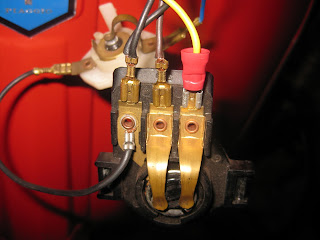Cylinder cowling was removed, got some issues with the old, hard petrol tube, but managed to get it off in one piece.
Same with cylinder. Some petrol was used to clean surfaces.
Cylinder walls feel OK. Due to the state of the cylinder, I did not feel it was neccessary to remove the cylinder completely.
The tank was removed for access to the petrol hose, which turned out to be tampered with. Previous owner obviously used what he had inhouse to fix the scooter. The old hose going to the carburettor was very stiff and was squeezed between the chassis and the cylinder cowling. Hose was removed completely, will be replaced with new.
When removing the carburettor, the complete inlet housing felt wobbly. And bingo: the screw for fastening the hosing to the motor wasn't tight. This could definetely cause the oil leakage, but can it also be the reason the scooter fails on high revs?
When removing the housing completely it is pretty apparent where the leakages have come from. (Screw attached for reference)
Thick layer of oily gravel on the carb housing, only one thing to do: Degrease & clean.
Surfaces after cleaning, now I need new gaskets.
The carb was splitted as well and given a clean in a petrol bath.
BE3 venturi and 118 jet. Bog standard.
Well, I need to order some gaskets before I get on with the mechanical side. As the gaskets need renewal and the carb is out anyway, I might as well do the gaskets on the carb too.
Electrical investigation continues. Headlamp connectors seem original, apart from the yellow fix.
According to the el schematics found on Scooterhelp the ignition lock should feature 8 different connectors. Mine only has 4. But as far as I can tell, the cabling has not been tampered with.
Which leaves me to suspect the panel to be tampered with. The part looks new, but I am not sure whether it has been replaced. I need the bike running for investigating further on this.
Good night.














No comments:
Post a Comment